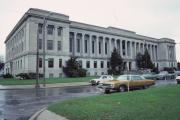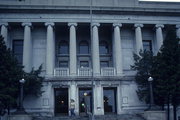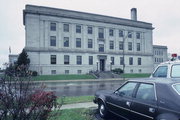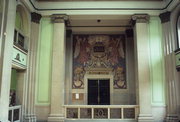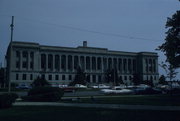Property Record
912 56TH ST
Architecture and History Inventory
| Historic Name: | Kenosha County Courthouse |
|---|---|
| Other Name: | Kenosha County Courthouse |
| Contributing: | Yes |
| Reference Number: | 9610 |
| Location (Address): | 912 56TH ST |
|---|---|
| County: | Kenosha |
| City: | Kenosha |
| Township/Village: | |
| Unincorporated Community: | |
| Town: | |
| Range: | |
| Direction: | |
| Section: | |
| Quarter Section: | |
| Quarter/Quarter Section: |
| Year Built: | 1923 |
|---|---|
| Additions: | |
| Survey Date: | 1999 |
| Historic Use: | courthouse |
| Architectural Style: | Neoclassical/Beaux Arts |
| Structural System: | |
| Wall Material: | Limestone |
| Architect: | Lindl, Lesser, & Schutte |
| Other Buildings On Site: | |
| Demolished?: | No |
| Demolished Date: |
| National/State Register Listing Name: | Civic Center Historic District |
|---|---|
| National Register Listing Date: | 7/26/1989 |
| National Register Multiple Property Name: | County Courthouses of Wisconsin Thematic Group |
| Additional Information: | A 'site file' exists for this property. It contains additional information such as correspondence, newspaper clippings, or historical information. It is a public record and may be viewed in person at the Wisconsin Historical Society, Division of Historic Preservation. An imposing Neoclassical structure rising three stories and faced with gray Indiana limestone, the Kenosha County Courthouse is distinguished by its chaste design, its colossal colonnade of unfluted Ionic columns, its commanding site as the centerpiece of the Kenosha Civic Center, and its lavish interior design. Surrounded by a broad lawn and rising three stories from a raised basement the massive rectangular building is composed of three horizontal elements divided by pronounced stone courses and profiled cornices, and anchored on either side by projecting pavilions. Rising two stories from a pedistal-like base story, the central colonnade is composed of 18 free-standing colossal columns, bracketed by corner pavilions with pilasters and columns. Behind the colonnade, tall rectangular windows rise through both stories, except above the central entry where the facade recedes to form a balcony with a balustrade and three round arched windows. The base story is punctuated with rectangular windows and three central doors framed by classical architraves and a cornice. Crowing the entire composition, an unornamented cornice, with inscribed frieze and dentils, is surmounted by a plain parapet. The horizontal divisions extend to the side and rear facades, but the colonnade is reduced to unornamented pilasters except in the rear corner pavilion where Ionic columns reappear. A dramatic interior central light court, illuminated by a colored, leaded glass skylight, and by round arched windows, rises three stories in the main entrance hall and is surrounded by balconies. Distinguished by a Botticino marble staircase and marble columns and pilasters, the interior court (and the adjacent hallways) are lavishly ornamented with molded ceiling details, hand-wrought iron balusters and grills, and "classical" mural art. The murals in the central hall were designed by A. E. Forigner and executed in muted tones of blue, gold and white. Symbolizing Civil Law, with winged figures bearing inscribed tablets, they surmount the entries to the courtrooms. The large mural on the third floor landing, entitled "In Memoriam," was designed by noted New York artist William De Leftwich-Dodge, and the courtroom murals were designed by Charles Holloway. The jail or safety building in the rear of the site is a three story limestone faced building connected to the courthouse by an underground passage. Although reduced in scale and ornament, the jail, like the courthouse, is divided into horizontal layers denoted by a projecting stone course and emphatic cornice. Stone architraves with bracketed cornices surround the doors and pilasters rise on the second and third stories on the north and south facades. Architectural Significance: The visual focal point of the Kenosha Civic Center, and a recognized landmark throughout the county, the Kenosha County Coruthouse is architecturally significant as an outstanding example of the Neoclassical style adapted to public buildings. Designed in 1923 by Lindl, Lesse and Schutte of Milwaukee, the building was completed in 1925 and adorned on the interior with murals by noted artists A. E. Foringer (who previously designed panels for the Utah State Supreme Court), William De Leftwich-Dodge (whose previous murals graced the Library of Congress, the Waldorf-Astoria Hotel, and the Administration Building at the 1893 World's Columbian Exposition in Chicago), Charles Holloway, and William Peaco. "Looming up like a giant among pygmies" (according to reports from the dedication day), (see Bib. Ref. B), the Kenosha County Courthouse was the initial unit in the Civic Center and served as an inspiration for the Neoclassical buildings which were to follow. The detached jail building, connected to the courthouse by an underground passage, echoes the severe Neoclassicism of the main building. More institutional than domestic, the jail is an early example of a more modern type of penal architecture in which the facility does not include a sheriff's residence. Historical Significance: Recognized throughout the state at the time of its construction as an eloquent testament to the City Beautiful movement, and heralded by national planning authorities as an inspiration to other small cities, the Kenosha County Courthouse is a significant lankmark in the history of the city planning movement in Wisconsin. The first and largest unit in Kenosha's monumnetal civic center, the courthouse was the result of unusual inter-governmental cooperation, signalling an early planning triumph for Wisconsin's first city-manager system. According to historian Nelson Peter Ross, the courthouse and the civic center which grew around it, "served as a crowning symbol of the new Kenosha," embodying the "progressive spirit of the city's leaders in the classic age of the manager system." (See Bib. Ref. A). Although the Kenosha County Board of Supervisors initially allocated funds and levied taxes for a new courthouse as early as 1918, those initial plans were abandoned because of the prohibitive cost. Not until March 1922, when the county floated a $500,000 bond issue and accepted the plans of architects Lindl, Lesser, and Schutte, did the new structure appear imminent. (See Bib. Ref. B). The course of construction was materially altered because of the adoption of a city manager system in Kenosha in the same year - the first such plan in the state. Under the leadership of City Manager Clare Osborn, and with the support of such municipal reformists as the Independent Voters League, Kenosha's new planning department proposed the concept of a monumental grouping of public buildings to include the new public high school, the federal post office, and the county court. (See Bib. Ref. C). The concept of a civic center was met with considerable enthusiasm. For Osborn and his planners, it represented an important "first priority." (See Bib. Ref. D). For the private business community it was the clarion call for a civic "loyalty which transcends individual comfort," (see bib. Ref. E) (according to a representative of the Kenosha Manufacturers Association). And for the county, whose courthouse would be the hallmark of the plan, it was nothing less than "the first magnificent unit of the new city." (See Bib. Ref. F). To implement the plan, Osborn hired noted St. Louis planner Harland Bartholomew whose lyric "plan of Kenosha" envisioned a cluster of classically inspired buildings. (See Bib. Ref. A). But the success of the plan depended on unusual cooperation between the city, the Board of Education, the Federal Government, and the county. After considerable work by Osborn and city council president Walter Alford (then vice-president of Nash Motors), Osborn and city council president Walter Alford (then vice-president of Nash Motors), a remarkable consensus was achieved among the various units, an appropriate site was determined, and the courthosue was located on the central axis of the Civic Center bounded by Market Street, Sheridan Road, Pearl Street, and Congress Street. (See Bib. Ref. F). Not only was the courthouse considered the "best of the west," (see Bib. Ref. B), the jail building was remarkably modern, with electronically controlled cell doors, exercise and shower rooms, special women's and juvenile sections, and a "model kitchen and dining room" facility. So thorough were the accomodations, the building did not require the ever-attentive presence of the sheriff nor the domestic talents of his wife. Instead, the sheriff maintained a suite of offices in the building and lived elsewhere, an arrangement considered unique at the time. (See Bib. Ref. B). Even before completion of the courthouse, the city and county were widely praised for their accomplishment. In 1924, after visiting the new structure, the Wisconsin Conference of Social Work awarded Kenosha fist place in the prestigous "Better City of Wisconsin contest," citing the city plans and the new courthouse as laudable accomplishments. (See Bib. Ref. G). More importantly, perhaps, in 1929 Harvard University planners Henry and Theodora Kimball Hubbard, praised the same achievements as an example to "other small cities of how much can be accomplished." The courthouse "forms part of a definite program of better civic appearance," they wrote. The civic center is "notable because ot forms part of a comprehensive plan." (See Bib. Ref. H). In 1925, these were considerable accomplishments for an urban center in Wisconsin. As the central element in those plans, the Kenosha County Courthouse is a historic remnant of an important era in city planning. |
|---|---|
| Bibliographic References: | A. Nelson Peter Ross, "Architecture, Planning and Transportation," in Kenosha County in the 20th Century; ed. by John Neuenschwander, (Kenosha: Kenosha County Bicentennial Commission, 1976), p. 441. B. Kenosha Evening News, August 25, 1925, (Vol. 31, No. 231), pp. 1-3. C. Ross, pp. 436-446. D. "Souvenir Kenosha County Courthouse" (Kenosha: Kenosha County City Clerk, 1925), p. 87. E. Quoted in Carrie Cropley, Kenosha: From Pioneer Village to Modern City (Kenosha: Kenosha County Historical Society, 1958), p. 132. F. "Souvenir Kenosha County Courthouse," p. 3. G. Henry Vincent Hubbard and Theodora Kimball Hubbard, Our Cities Today and Tomorrow: A survey of Planning and Zoning Progress in the United States. (Cambridge: Harvard University Press, 1929), p. 360. H. Hubbard, p. 133, p. 266. |
| Wisconsin Architecture and History Inventory, State Historic Preservation Office, Wisconsin Historical Society, Madison, Wisconsin |

